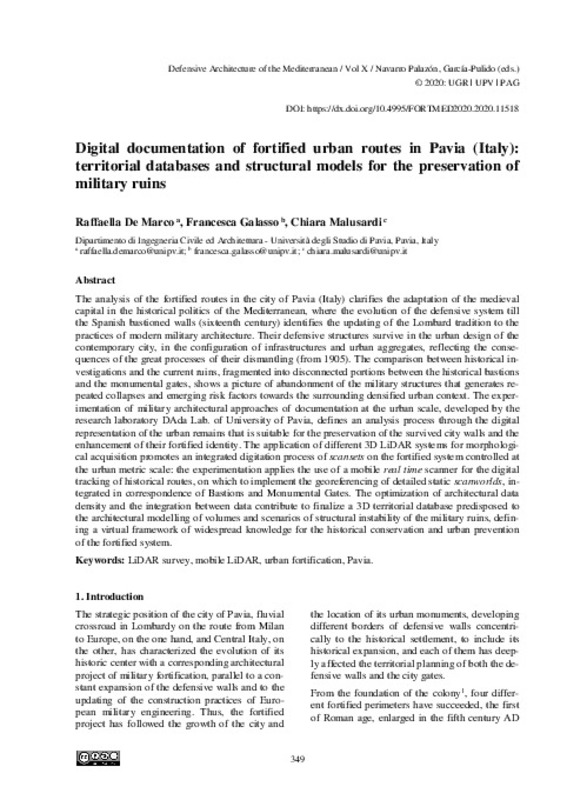JavaScript is disabled for your browser. Some features of this site may not work without it.
Buscar en RiuNet
Listar
Mi cuenta
Estadísticas
Ayuda RiuNet
Admin. UPV
Digital documentation of fortified urban routes in Pavia (Italy): territorial databases and structural models for the preservation of military ruins
Mostrar el registro sencillo del ítem
Ficheros en el ítem
| dc.contributor.author | De Marco, Raffaella
|
es_ES |
| dc.contributor.author | Galasso, Francesca
|
es_ES |
| dc.contributor.author | Malusardi, Chiara
|
es_ES |
| dc.coverage.spatial | east=9.1582069; north=45.1847248; name=Corso Giuseppe Mazzini, 18/20, 27100 Pavia PV, Itàlia | es_ES |
| dc.date.accessioned | 2020-07-17T11:41:29Z | |
| dc.date.available | 2020-07-17T11:41:29Z | |
| dc.date.issued | 2020-05-15 | |
| dc.identifier.isbn | 9788490488560 | |
| dc.identifier.uri | http://hdl.handle.net/10251/148206 | |
| dc.description.abstract | [EN] The analysis of the fortified routes in the city of Pavia (Italy) clarifies the adaptation of the medieval capital in the historical politics of the Mediterranean, where the evolution of the defensive system till the Spanish bastioned walls (sixteenth century) identifies the updating of the Lombard tradition to the practices of modern military architecture. Their defensive structures survive in the urban design of the contemporary city, in the configuration of infrastructures and urban aggregates, reflecting the consequences of the great processes of their dismantling (from 1905). The comparison between historical investigations and the current ruins, fragmented into disconnected portions between the historical bastions and the monumental gates, shows a picture of abandonment of the military structures that generates repeated collapses and emerging risk factors towards the surrounding densified urban context. The experimentation of military architectural approaches of documentation at the urban scale, developed by the research laboratory DAda Lab. of University of Pavia, defines an analysis process through the digital representation of the urban remains that is suitable for the preservation of the survived city walls and the enhancement of their fortified identity. The application of different 3D LiDAR systems for morphological acquisition promotes an integrated digitation process of scansets on the fortified system controlled at the urban metric scale: the experimentation applies the use of a mobile real time scanner for the digital tracking of historical routes, on which to implement the georeferencing of detailed static scanworlds, integrated in correspondence of Bastions and Monumental Gates. The optimization of architectural data density and the integration between data contribute to finalize a 3D territorial database predisposed to the architectural modelling of volumes and scenarios of structural instability of the military ruins, defining a virtual framework of widespread knowledge for the historical conservation and urban prevention of the fortified system | es_ES |
| dc.language | Inglés | es_ES |
| dc.publisher | Editorial Universitat Politècnica de València | es_ES |
| dc.rights | Reconocimiento - No comercial - Sin obra derivada (by-nc-nd) | es_ES |
| dc.subject | Fortifications | es_ES |
| dc.subject | Mediterranean | es_ES |
| dc.subject | Modern age | es_ES |
| dc.subject | Built Heritage | es_ES |
| dc.subject | LiDAR survey | es_ES |
| dc.subject | mobile LiDAR | es_ES |
| dc.subject | Urban fortification | es_ES |
| dc.subject | Pavia | es_ES |
| dc.title | Digital documentation of fortified urban routes in Pavia (Italy): territorial databases and structural models for the preservation of military ruins | es_ES |
| dc.type | Capítulo de libro | es_ES |
| dc.type | Comunicación en congreso | es_ES |
| dc.identifier.doi | 10.4995/FORTMED2020.2020.11518 | |
| dc.rights.accessRights | Abierto | es_ES |
| dc.description.bibliographicCitation | De Marco, R.; Galasso, F.; Malusardi, C. (2020). Digital documentation of fortified urban routes in Pavia (Italy): territorial databases and structural models for the preservation of military ruins. Editorial Universitat Politècnica de València. 349-356. https://doi.org/10.4995/FORTMED2020.2020.11518 | es_ES |
| dc.description.accrualMethod | OCS | es_ES |
| dc.relation.conferencename | FORTMED2020 - Defensive Architecture of the Mediterranean | es_ES |
| dc.relation.conferencedate | Octubre 01-03,2020 | es_ES |
| dc.relation.conferenceplace | Granada, Spain | es_ES |
| dc.relation.publisherversion | http://ocs.editorial.upv.es/index.php/FORTMED/FORTMED2020/paper/view/11518 | es_ES |
| dc.description.upvformatpinicio | 349 | es_ES |
| dc.description.upvformatpfin | 356 | es_ES |
| dc.type.version | info:eu-repo/semantics/publishedVersion | es_ES |
| dc.relation.pasarela | OCS\11518 | es_ES |








